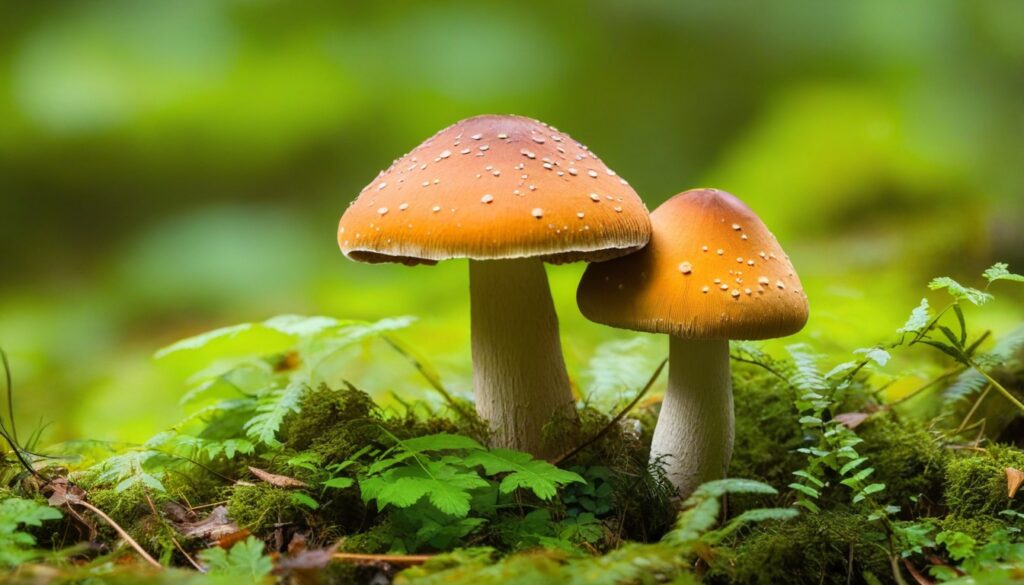Welcome to our comprehensive guide on edible mushrooms in New England, perfect for both seasoned foragers and beginners looking to explore the wilds of this captivating region. Here, we’ll delve deep into the topic, from the benefits of foraging to safe mushroom harvesting practices and delicious culinary uses.
Key Takeaways:
- Discover the benefits of foraging for edible mushrooms in New England.
- Understand the mushroom seasons in the region and which mushrooms thrive during each time of the year.
- Learn to identify common and rare edible mushroom species in New England.
- Follow safe mushroom foraging practices to ensure your safety and sustainability of the ecosystem.
- Explore the different culinary possibilities of edible mushrooms and learn how to store and preserve your foraged finds.
The Benefits of Foraging for Edible Mushrooms
Foraging for edible mushrooms in the beautiful region of New England offers a range of benefits. Firstly, it’s a sustainable activity that enables you to enjoy locally sourced, organic produce while reducing your carbon footprint. Furthermore, foraging is a great way to get some exercise and fresh air, allowing you to connect with nature and disconnect from the stresses of daily life.
Edible mushrooms are also incredibly nutritious and diverse, making them an excellent addition to any diet. They contain a range of vitamins, minerals, and antioxidants, and research suggests that mushrooms may have immune-boosting and anti-inflammatory properties.
Foraging for edible mushrooms can also be a social activity, allowing you to spend time with friends and family while exploring the great outdoors. And last but not least, let’s not forget the culinary delights that await you. From adding them to your morning omelet to incorporating them into hearty stews and soups, the possibilities with edible mushrooms are endless!
New England’s Mushroom Season
Foraging for mushrooms is a seasonal activity in New England. Understanding the different seasons and the specific mushrooms that thrive during each time of the year is essential for a successful hunt. While the mushroom season varies depending on the weather, below is a general overview of the best times to forage for specific mushrooms:
|
Mushroom |
Season |
|---|---|
|
Morels |
Spring (April – June) |
|
Chanterelles |
Summer (July – September) |
|
Honey Mushrooms |
Fall (September – November) |
Note that these are only general guidelines, and the actual timing of the mushroom season varies from year to year depending on the weather patterns. It’s always a good idea to keep an eye on the weather forecast and consult with local experts to know the best time to start your mushroom hunt.
Additionally, keep in mind that different mushrooms thrive in different types of habitats and environments. For example, morels tend to grow in moist and cool areas with decaying leaves, while chanterelles prefer drier and sunnier spots with grass and soil. Knowing the specific environments where each mushroom grows is crucial to successful foraging.
Come prepared with the right gear and tools such as a good foraging basket or bag, a knife, and a field guide to help identify the different mushroom species. With the right knowledge and preparation, you’ll be able to find a variety of edible mushrooms during their prime growing season in New England.
Common Edible Mushrooms in New England
New England boasts a diverse range of edible mushrooms that are frequently found in the region. Here are some of the most common species:
|
Name |
Description |
Identifying Features |
|---|---|---|
|
Chanterelle |
A prized mushroom with a fruity aroma and a golden color that stands out amidst the forest floor. |
Deep, vase-shaped cap with wavy edges and false gills running down the stem. |
|
Morel |
Distinctly shaped and highly prized, with a nutty, earthy flavor and a spongy texture. |
Honeycomb-textured cap with a hollow, cone-shaped body. |
|
Oyster |
An excellent choice for beginners, with a mild flavor and a satisfying texture. |
Thin, oyster-shaped cap that grows in clusters on trees or decaying wood. |
|
Bolete |
A flavorful mushroom with a meaty texture that often grows in symbiosis with trees. |
Thick, fleshy stem with a cap that ranges from brown to red in color. |
|
Black Trumpet |
A unique mushroom that has a rich, smoky flavor and a trumpet-shaped body. |
Black, funnel-shaped cap that fades to gray at the edges. |
When foraging for edible mushrooms, always take care to properly identify each species and ensure that they are safe to consume. While these mushrooms are commonly found in New England, it is important to research and consult with experts before consuming any wild mushrooms.
Rare Edible Mushrooms to Discover in New England
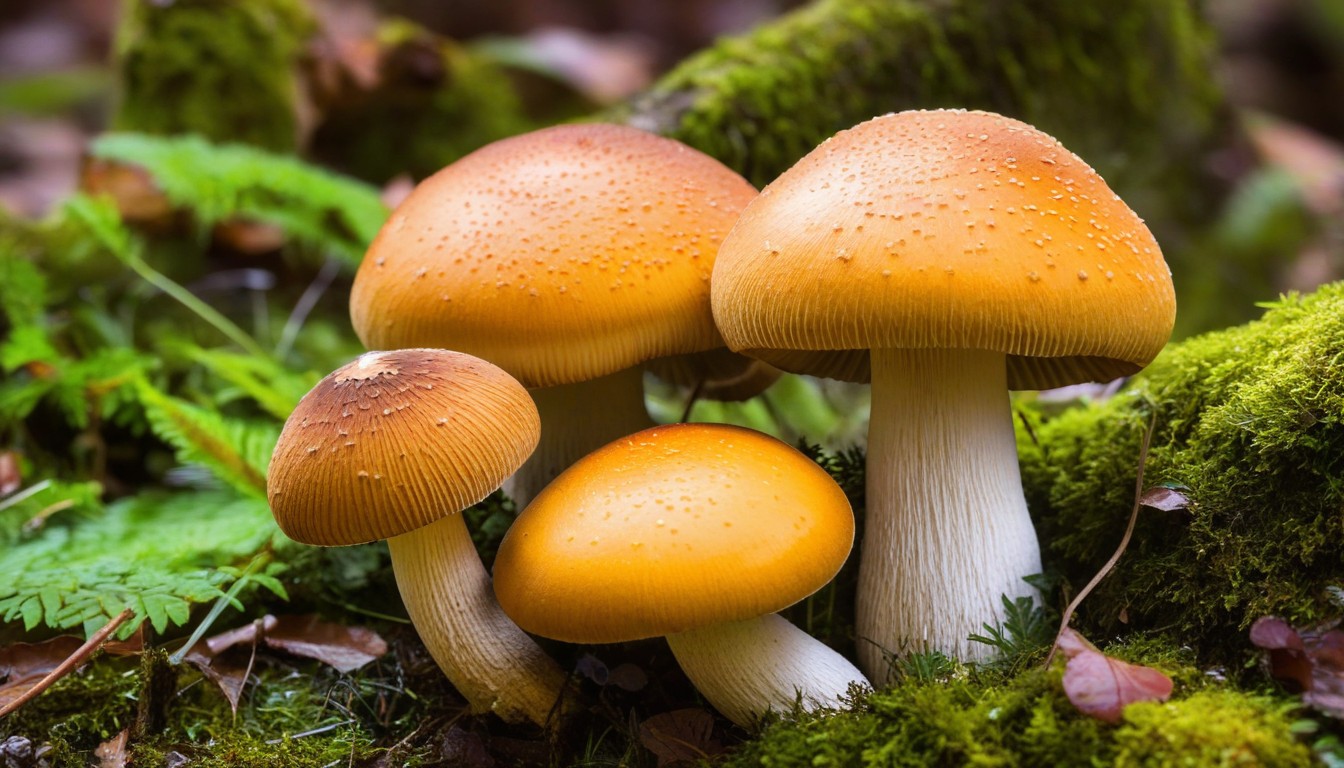
While edible mushrooms are plentiful in New England, there are also uncommon and rare varieties that are worth exploring. These mushrooms are not only a culinary delight but also offer unique nutritional benefits.
One rare mushroom species found in New England is the Hen of the Woods (Grifola frondosa), also known as Maitake. This large, fan-shaped mushroom is rich in antioxidants and beta-glucans, which support the immune system and may have anti-cancer properties. Maitake mushrooms have a meaty and earthy flavor, making them a delicious addition to stir-fries and soups.
Another rare and prized mushroom found in New England is the Porcini (Boletus edulis). These mushrooms are known for their rich, nutty flavor and meaty texture. Porcini mushrooms can be cooked in various ways, including grilling, roasting, or sautéing. They are also a good source of vitamin D and potassium.
Rare Edible Mushrooms in New England
|
Mushroom Name |
Description |
Taste |
Nutrition |
|---|---|---|---|
|
Hen of the Woods |
A large, fan-shaped mushroom that grows in clusters |
Meaty and earthy |
Rich in antioxidants and beta-glucans |
|
Porcini |
A brown-capped mushroom with a thick stem |
Nutty and meaty |
Good source of vitamin D and potassium |
|
Black Trumpet |
A funnel-shaped mushroom with a black exterior and delicate flesh |
Earthy and fruity |
Rich in vitamin B and D, Iron, and Copper |
Other rare edible mushrooms found in New England include the Black Trumpet (Craterellus cornucopioides) with its earthy and fruity taste, rich in vitamin B and D, iron, and copper, and the Matsutake (Tricholoma matsutake), an aromatic and nutty mushroom highly valued in Japanese cuisine.
When foraging for rare mushrooms, it’s important to exercise caution and enlist the help of an experienced guide to avoid any harmful or toxic varieties. With care, the discovery of a rare edible mushroom is a memorable and delicious experience.
Safe Mushroom Foraging Practices
Foraging for mushrooms can be a thrilling experience, but it’s important to follow safe practices to ensure your well-being and protect the environment.
1. Know Your Mushrooms
Before heading out to forage, it’s essential to familiarize yourself with the edible and poisonous mushroom species in New England. Carry a reliable field guide and learn to identify the species correctly.
2. Choose Safe Areas
Forage only in areas known to be safe, such as public lands, parks, and forests, and avoid private property without permission. Stay away from roadsides, contaminated soil, and areas treated with pesticides or other chemicals.
3. Leave No Trace
Forage responsibly by leaving the harvest area as you found it. Don’t damage the environment or disturb wildlife habitats. Avoid over-harvesting by taking only what you need, leaving some mushrooms for others and the ecosystem.
4. Use Proper Tools
Use a sharp knife, scissors, or hand pruners to cut the mushrooms at the base of the stem, leaving the rooting system intact. Don’t pull the mushrooms out of the ground, as it can damage the mycelium and compromise future growth.
5. Handle with Care
Handle your harvest with care to prevent damage or bruising. Carry the mushrooms in a basket or paper bag, never in a plastic bag as it can cause them to sweat and spoil.
Remember, never eat any wild mushroom unless you are 100% sure of its identification and safety.
Poisonous Mushroom Species to Avoid in New England
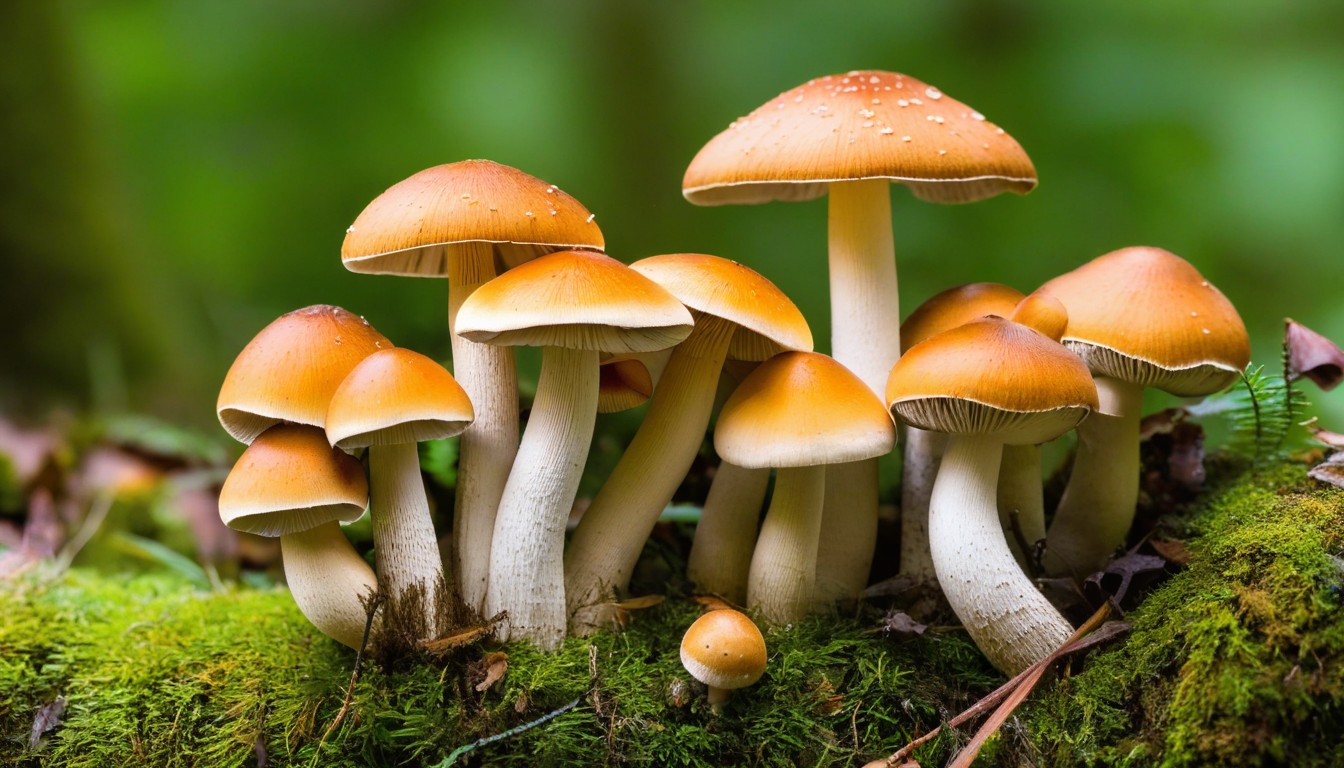
New England is home to many stunning and delicious edible mushrooms, but there are also some toxic species to be aware of. Eating a poisonous mushroom can be dangerous, and in severe cases, even deadly. Therefore, it’s essential to be able to differentiate between edible and poisonous mushrooms when foraging. Here are some of the most common poisonous mushroom species in New England:
|
Common Name |
Scientific Name |
Description |
|---|---|---|
|
Amanita phalloides |
Amanita phalloides |
Also known as the “death cap,” this mushroom is deadly even if consumed in a small amount and can be mistaken for edible varieties. |
|
Jack O’Lantern |
Omphalotus illudens |
Although it is not fatal, consuming this mushroom can cause severe stomach cramps and vomiting. |
|
False Morel |
Gyromitra esculenta |
The false morel looks similar to the edible morel, but it contains a toxin that can cause gastrointestinal distress, seizures, and even death. |
When foraging for mushrooms, always err on the side of caution. If you are unsure about the edibility of a mushroom, leave it be and seek guidance from a mushroom expert or online resource. Remember, the excitement of foraging should not come at the expense of personal safety.
Tips for Proper Mushroom Harvesting
Harvesting edible mushrooms sustainably not only helps maintain their quality but also the ecosystem. Here are some useful tips to ensure you are harvesting mushrooms responsibly:
- Know your mushrooms: Before you start harvesting, familiarize yourself with the various types of edible mushrooms and their identifying features. It’s crucial to distinguish them from poisonous counterparts.
- Choose mature mushrooms: Harvest mature mushrooms since they are more flavorful and nutrient-dense. Avoid picking small or immature mushrooms that need time to grow and release spores.
- Use a sharp knife: A sharp knife ensures a clean, precise cut and minimizes damage to the surrounding environment.
- Don’t pull the mushrooms: Avoid plucking mushrooms from the ground since it can disrupt the surrounding mycelium and damage the environment. Cut them at the base of the stem instead.
- Leave some mushrooms behind: Never harvest all the mushrooms from a particular area to allow the remaining ones to reproduce and support the ecosystem’s health.
- Carry a basket: Use a basket that allows spores to scatter and fall to the ground to promote new growth. Avoid plastic bags that trap moisture and accelerate the decomposition process.
By following these tips, you can ensure you are harvesting mushrooms safely and sustainably, leaving the environment healthier for future generations of mushroom lovers.
Culinary Delights: Cooking with Edible Mushrooms
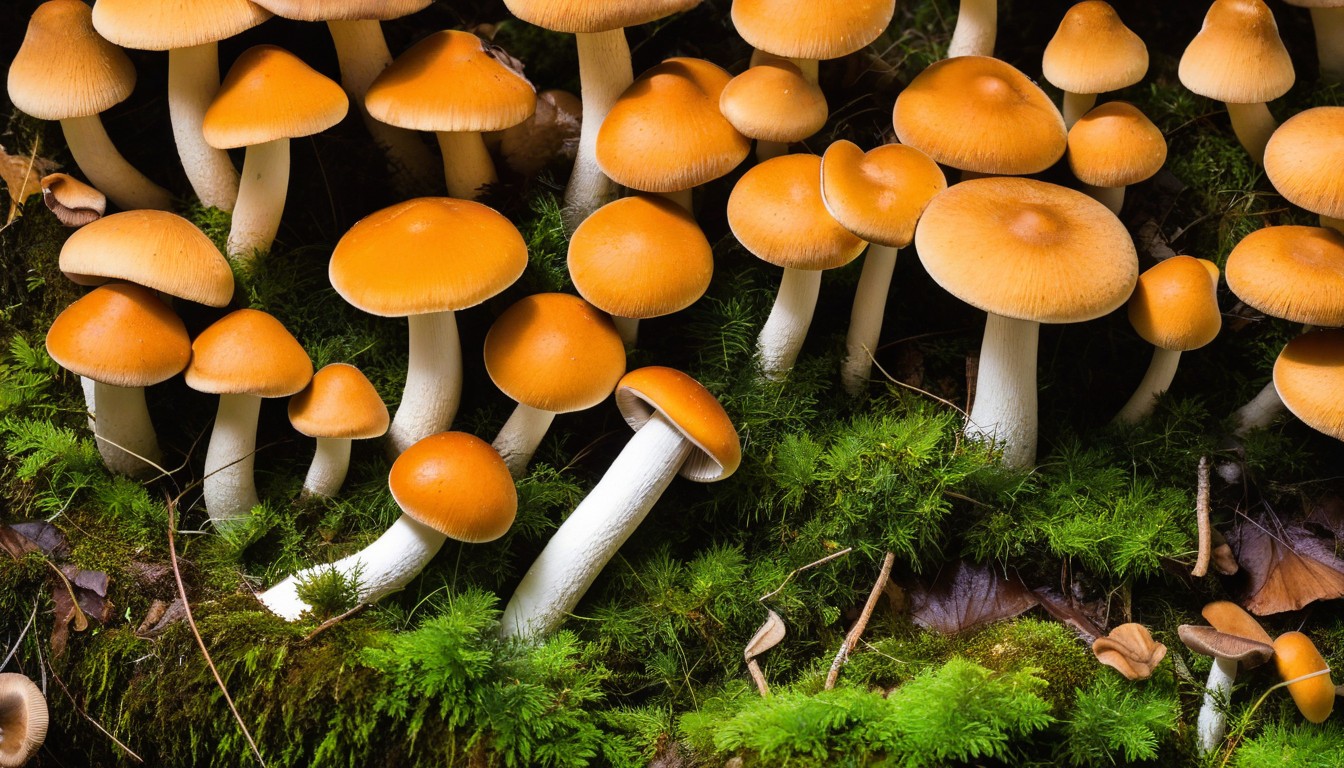
Congratulations on your successful mushroom foraging trip! Now it’s time to transform your finds into delectable dishes. Edible mushrooms are versatile ingredients that can be used in a variety of cooking styles from sautéing to baking.
One classic and simple recipe is sautéed mushrooms with garlic and olive oil. For a twist, you can add sliced onions or thyme to enhance the flavors. To create an umami explosion, try making mushroom risotto or a creamy mushroom soup.
If you’re feeling adventurous, experiment with using edible mushrooms in place of meat in recipes, such as mushroom burgers or mushroom stroganoff. You can also pickle them to add a zesty flavor to your salads or sandwiches.
Recipe: Mushroom Risotto
|
Ingredients |
Instructions |
|---|---|
|
|
Remember to always properly clean and cook your mushrooms before consuming them. With your newfound knowledge on edible mushrooms, you can confidently add these culinary delights to your meals and impress your family and friends with your foraging skills and culinary creations.
Preserving and Storing Edible Mushrooms
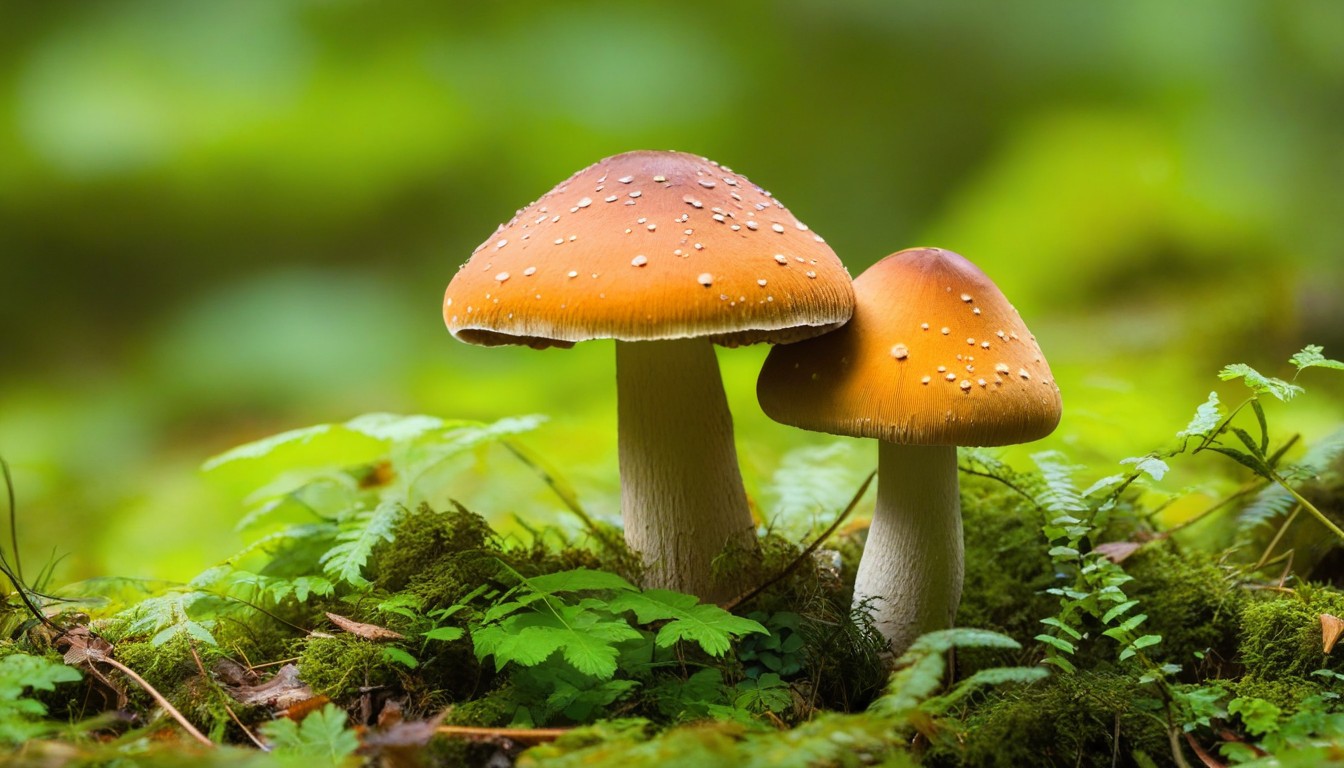
After gathering a bountiful harvest of edible mushrooms, you’ll want to preserve them to enjoy their flavors for as long as possible. Proper preservation and storage methods are critical to preventing spoilage and maintaining freshness.
Drying
Drying is one of the most common and traditional methods of preserving mushrooms. You can air-dry them by simply hanging them upside down in a dry, well-ventilated area. You can also use a dehydrator to speed up the process, which can take anywhere from a few hours to a few days depending on the variety and size of the mushrooms.
Tip: To rehydrate the mushrooms, soak them in water or broth for about 30 minutes, then use them as fresh.
Canning
Canning is another popular preservation method that involves sterilizing jars and processing the mushrooms with heat. The heat helps to kill any bacteria, ensuring long-term preservation. Follow specific instructions carefully to avoid any contamination or spoilage.
Freezing
Freezing is a fast and easy preservation method that preserves the texture and flavor of the mushrooms. Pre-freeze the mushrooms on baking sheets, so they don’t stick together, and then store them in airtight containers or freezer bags. Mushrooms can be kept frozen for up to six months.
Storing Fresh Mushrooms
If you’re planning on using the fresh mushrooms within a day or two, you can store them in a paper bag in the refrigerator. Alternatively, you can wrap them in a damp towel, which will keep them from drying out. Never store mushrooms in airtight containers, as this can cause them to spoil quickly due to excess moisture.
Preserving and storing edible mushrooms ensure you can enjoy their flavors far beyond the end of the mushroom season. Try different methods and decide which one works best for you and the type of mushrooms you have.
New England Mushroom Foraging Clubs and Resources
Foraging for mushrooms is a fun and rewarding activity, but it can be even better when you’re part of a like-minded community. Fortunately, there are plenty of mushroom foraging clubs in New England, where you can learn from experienced foragers and share your own knowledge and experiences.
One of the most popular foraging clubs in the region is the New England Wild Edibles group. They organize regular forays to local mushroom hotspots and offer workshops on identification, harvesting, and cooking. Membership is open to anyone with a passion for foraging, regardless of skill level or experience.
If you prefer to connect with other foragers online, there are plenty of forums and social media groups dedicated to mushroom hunting in New England. The New England Mushroom Hunting group on Facebook, for example, has over 2,000 members and provides a platform for sharing photos, tips, and tricks.
When it comes to resources, there are also plenty of books and online guides available to help you in your mushroom foraging journey. Some of the most popular titles include Mushrooming with Confidence by Alexander Schwab and The Complete Mushroom Hunter by Gary Lincoff. These resources provide detailed information on identification, habitat, and cooking, making them essential reading for any serious forager.
|
Resource |
Description |
|---|---|
|
Wild Edible Mushrooms of New England |
A comprehensive guidebook to identifying and harvesting mushrooms in the New England region. Includes full-color photographs and detailed descriptions of over 100 species. |
|
New England Mushroom Company |
A gourmet mushroom farm in Massachusetts that offers mushroom CSA shares, farm tours, and educational workshops. They also sell a variety of cultivated and wild-foraged mushrooms. |
|
Myco Alliance |
A non-profit organization that promotes mushroom cultivation and foraging as a means of ecological regeneration. They offer workshops, consulting services, and online courses. |
Whether you’re a seasoned forager or just starting out, connecting with other mushroom enthusiasts and utilizing the wealth of available resources can greatly enhance your mushroom foraging experience in New England.
Conclusion
Foraging for edible mushrooms in New England is an exciting and rewarding experience that offers numerous benefits. By following safe practices and identifying common and rare species, you can harvest these culinary delights with confidence.
Remember to always prioritize sustainability and the well-being of the ecosystem. Proper harvesting techniques, storage methods, and culinary preparation can help you make the most of your foraged finds.
If you’re looking to connect with like-minded foragers and learn more about this fascinating activity, consider joining a local club or online community. With the right resources and knowledge, you can embark on an unforgettable mushroom foraging journey in New England.
So what are you waiting for? Put on your hiking boots and head out to discover the unique and delicious edible mushrooms that New England has to offer. Happy foraging!
FAQ
What are the benefits of foraging for edible mushrooms?
Foraging for edible mushrooms offers numerous benefits, such as connecting with nature, obtaining fresh and nutritious food, and engaging in a sustainable and rewarding activity.
Which mushrooms are commonly found in New England?
New England is home to several common edible mushroom species, including the popular chanterelle, morel, and oyster mushrooms. These mushrooms can be found in various habitats throughout the region.
Are there rare edible mushrooms in New England?
Yes, New England also boasts some rare and uncommon edible mushrooms that are worth seeking out. Some examples include the black trumpet, matsutake, and lobster mushrooms.
How can I forage for edible mushrooms safely?
It is essential to follow safe mushroom foraging practices. This includes accurately identifying mushrooms, avoiding contaminated areas, and seeking guidance from experienced foragers or joining local foraging clubs.
Which poisonous mushroom species should I avoid in New England?
New England has several poisonous mushroom species that should be avoided. Examples include the deadly amanita species, such as the death cap and destroying angel mushrooms.
What are some tips for properly harvesting edible mushrooms?
To ensure sustainable harvesting, start by using a sharp knife to cut the mushroom at the base of the stem. Avoid picking immature or small mushrooms, and leave some behind to allow for spore dispersal and future growth.
How can I cook with edible mushrooms?
Edible mushrooms can be used in a wide range of delicious recipes. They can be sautéed, roasted, grilled, or used as a flavorful addition to soups, stews, pasta dishes, and more.
How can I preserve and store edible mushrooms?
There are various methods for preserving and storing edible mushrooms, including drying, freezing, pickling, and canning. Each method has its own advantages and is suitable for different culinary uses.
Are there any mushroom foraging clubs or resources in New England?
Yes, there are mushroom foraging clubs and valuable resources in New England. These include local clubs, online communities, and websites that provide information, workshops, and resources for mushroom enthusiasts.

